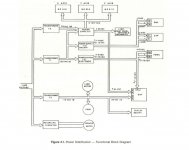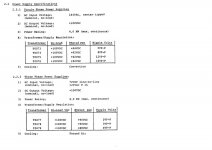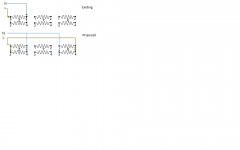alastairseggie
Aluminum
- Joined
- Jun 26, 2013
- Location
- UK
Hi All
I recently purchased a Bridgeport R2E3 CNC machine. I have so far managed to repair the damaged circuit boards and the blown PSU I have single phased everything except the Motor which I have running (very roughly) using capacitors. I intend putting an inverter on this and it all works.
Now the servo Drives are fed from a three phase transformer which is giving me a headache. Here is the plate info and a pic of the physical transformer:


The primary has two windings which are used in the 230v config. These are run in series for 460V and in parallel for 230V as given on the plate data. My thinking was to common up X1,Y1,Z1,X3,Y3,Z3 and connect the 230v single phase live there then common up the X2,Y2,Z2,X4,Y4,Z4 and connect the neutral.
This just tripped the breaker.
Next I connected X1 to X3 to Live and X2 to X4 to neutral this draws about 2A, I then decided to add another winding from the Y leg and connected X1 to X3 to Y1 to Live and X2 to X4 to Y2 to neutral this draws 85A and I hit the panic button to switch it off. This makes no sense to me.
With X1 to X3 to Live and X2 to X4 to neutral I get enough from the secondary windings to run the servos unloaded (just the table), but I suspect that if any load was placed on them there would be issues as there would be only 2 out of 6 primary coils providing the magnetic flux.
Can anyone explain what is happening here and why two coils draw 2A and three draw 85A?
Also can what I am trying to do even be done i.e. run all the 6 primary coils in series from a single phase supply?
I have a good electrical and Electronics understanding but this has me beat.
Alastair
I recently purchased a Bridgeport R2E3 CNC machine. I have so far managed to repair the damaged circuit boards and the blown PSU I have single phased everything except the Motor which I have running (very roughly) using capacitors. I intend putting an inverter on this and it all works.
Now the servo Drives are fed from a three phase transformer which is giving me a headache. Here is the plate info and a pic of the physical transformer:


The primary has two windings which are used in the 230v config. These are run in series for 460V and in parallel for 230V as given on the plate data. My thinking was to common up X1,Y1,Z1,X3,Y3,Z3 and connect the 230v single phase live there then common up the X2,Y2,Z2,X4,Y4,Z4 and connect the neutral.
This just tripped the breaker.
Next I connected X1 to X3 to Live and X2 to X4 to neutral this draws about 2A, I then decided to add another winding from the Y leg and connected X1 to X3 to Y1 to Live and X2 to X4 to Y2 to neutral this draws 85A and I hit the panic button to switch it off. This makes no sense to me.
With X1 to X3 to Live and X2 to X4 to neutral I get enough from the secondary windings to run the servos unloaded (just the table), but I suspect that if any load was placed on them there would be issues as there would be only 2 out of 6 primary coils providing the magnetic flux.
Can anyone explain what is happening here and why two coils draw 2A and three draw 85A?
Also can what I am trying to do even be done i.e. run all the 6 primary coils in series from a single phase supply?
I have a good electrical and Electronics understanding but this has me beat.
Alastair








